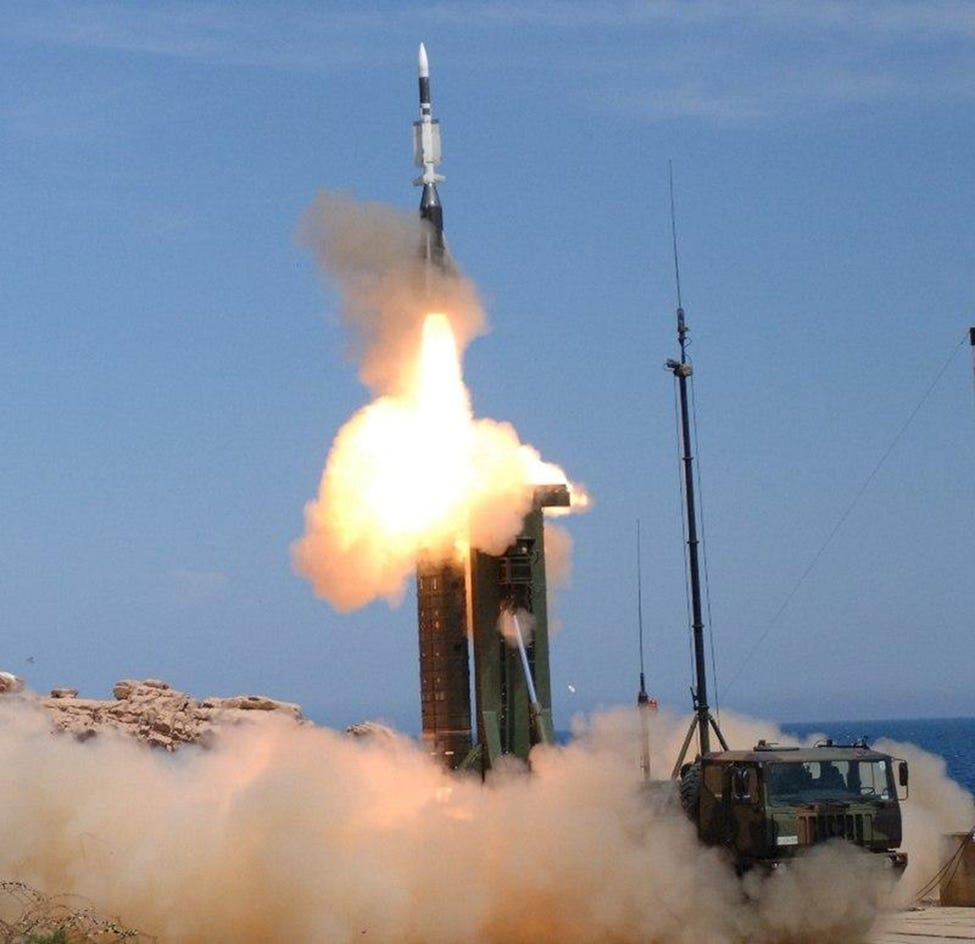Why Putin's Missiles are still getting through: Ukraine's Blind Spot in the Sky
by Benjamin Cook
As Russian ballistic missile attacks continue to target Ukrainian cities, one question sits at the center of Ukraine’s national defense: what can actually shoot these down?
Ukraine has become one of the most sophisticated air defense environments in the world. It routinely defeats Russian cruise missiles, drones, and glide bombs using a layered network of Western systems, Ukrainian ingenuity, and electronic warfare. But ballistic missiles are a different category of threat. They descend at extremely high speeds, on steep trajectories, and are much harder to intercept. The margin for error is measured in milliseconds.
Right now, the United States’ Patriot and the European SAMP-T systems are the only proven solutions deployed in Ukraine, confirmed to have successfully intercepted Russian ballistic missiles - including Kinzhal air-launched ballistic missiles and Iskander-M short-range ballistic missiles. It is widely acknowledged that Ukraine-operated Patriots have achieved what few systems elsewhere in the world have: combat-proven intercepts against maneuvering hypersonic targets.
France and Italy’s SAMP/T system is deployed in Ukraine and has been credited with at least one successful intercept of a Russian aircraft. It uses the Aster 30 missile and was designed with some anti-ballistic capability, although its effectiveness against Russian ballistic threats has not been publicly confirmed. While some of US media is attempting to tarnish the reputation of the SAMP/T system, Ukrainians report to be very happy about it: only complaining about very low stocks of missiles for them.
The upgraded SAMP/T NG, still in development, is specifically built to intercept ballistic missiles. With a new AESA radar and the Aster 30 Block 1NT missile, it is Europe’s intended answer to Patriot. But there is no evidence that it has been deployed to Ukraine, tested in combat, or evaluated under live conditions. Ukraine’s battlefield data is unparalleled—and yet it appears, SAMP/T NG remains absent from it.
The German IRIS-T system, particularly the SLM variant, is among Ukraine’s most prized medium-range platforms. It has demonstrated exceptional performance against cruise missiles and drones, and in terms of uptime, readiness, and cost-per-shot, it’s widely respected. However, there is no public evidence that IRIS-T has successfully engaged a ballistic missile. Diehl Defence is working on enhanced variants such as the IRIS-T SLX, and has signed a new cooperation agreement with Ukraine, but as of now, ballistic capability remains speculative.
Hate Subscriptions? Me too! You can support me with a one time contribution to my research at Buy Me a Coffee. https://buymeacoffee.com/researchukraine
NASAMS, co-developed by Norway and the United States, is another staple of Ukraine’s air defense network. It uses the AIM-120 AMRAAM, which excels against aircraft and cruise missiles. Its range and reaction speed are good, but it is not designed to intercept modern ballistic missiles. Like IRIS-T, it’s an essential part of the air defense ‘ecosystem’—but not a solution to the ballistic missile threat.
Meanwhile, and although its own government has managed to spoil series production of domestically designed and manufactured air defence missiles, Ukraine is not standing still. Its defense industry has already successfully tested its own domestically produced ballistic missiles. In parallel, Ukraine’s Ministry of Defence has invited European defense firms to participate in the co-development of an entirely new, long-range air defense system with ballistic missile interception capability. This shows Ukraine’s strategic intent: to become a producer and not just a consumer of modern air defense solutions.
Ukraine has proven its ability to shoot down cruise missiles, drones, glide bombs, and even hypersonic air-launched threats. But the country still faces a severe shortage of systems that can consistently defend against the most difficult category of attacks—ballistic missiles.
Intercepting a ballistic missile requires an entirely different level of detection, tracking, and precision. Because ballistic missiles travel at hypersonic speeds during their terminal phase, the defending system must first detect the missile’s launch with long-range radar and then track it through its midcourse trajectory using high-resolution, phased-array radar—ideally AESA (Active Electronically Scanned Array) type, which can track multiple fast-moving targets simultaneously. Once the target is acquired, the interceptor missile needs an advanced seeker—usually radar-based, sometimes with infrared capability—to guide itself during the final seconds of flight. The most capable systems use a 'hit-to-kill' method, which requires the interceptor to physically collide with the missile, demanding incredibly precise flight control.
To achieve this, the interceptor must be equipped with thrust vectoring or advanced control surfaces that allow mid-course corrections. This enables the missile to change direction in response to real-time tracking data and close in on a target moving at Mach 5 or faster. Any lag in communication, sensor fusion, or maneuverability can result in a miss. That’s what makes ballistic missile defense so hard—and why so few systems have demonstrated real-world success. Interception at these speeds demands near-zero latency between the interceptor’s onboard seeker and its control surfaces. The guidance processor must ingest real-time tracking data, make predictive trajectory corrections, and issue control commands within microseconds. This requires extremely high processing speeds and hardened software to prevent lag or failure under stress. The seeker head—often an active radar or dual-mode seeker—must not only lock on but stay locked on, despite the heat, clutter, and countermeasures of the high-speed engagement environment. That makes this the defining technical and strategic challenge of Ukraine’s air war.
The otherside of the same coin—developing ballistic missiles of its own with the range, payload, and precision not to intercept arrows mid-flight, but to destroy the archer and the bow maker. Grounded missile launchers, airbases, and the Russian defense-industrial complex itself become the targets. Ukraine is already doing this with some success. It’s not missile defense in the traditional sense—it’s deterrence through destruction of the means of war itself.
Benjamin Cook continues to travel to, often lives in, and works in Ukraine, a connection spanning more than 14 years. He holds an MA in International Security and Conflict Studies from Dublin City University and has consulted with journalists on AI in drones, U.S. military technology, and related topics. He is co-founder of the nonprofit UAO, working in southern Ukraine. You can find Mr. Cook between Odesa, Ukraine; Charleston, South Carolina; and Tucson, Arizona.
Hate Subscriptions? Me too! You can support me with a one time contribution to my research at Buy Me a Coffee. https://buymeacoffee.com/researchukraine
Mr. Cook’s Substack:








The problem with intercepting ballistic missiles is cost effectiveness, it always cost more to intercept a missile than to make a new one (total system costs) , the launcher always control the timing and the target location, sure Trumps golden dome and Israel's ABM umbrella can spend lavishly even extravagantly to make a statement against none state actors and failed states without a real missile force but proves totally inadequate against an enemy that can really saturate and penetrate the most solid ABM currently in the world that have ample regional buffer zone and and even more lenient target space and types to cover and comfort time window to respond as we have seen in the case of the Iranian missile strike on Tel Aviv.
In the long run strategic bombardment is won by logistics and the ability to penetrate the target defenses and manufacturing and storage infrastructure, any how missiles are poor substitute for other strategic bombardment means and simply using them to terrorize civilians and inviting a retaliation strikes against own civilians is ultimately futile and wasteful from the military sense.
Ukraine knows this and use what they got to target military infrastructure and manufacturing capacities and this should be the focus of the military aid , the Russian regime can not afford to taeget civilians if every attack was followed by a massive retaliation against Russian economic and military infrastructure in the strategic depth.
Meanwhile the ABM defence network of Ukraine can not be stretched to protect every civilian target with out exposing vital war efforts targets which is why the the Russian regime is targeting civilians to begin with
"Right now, the United States’ Patriot and the European SAMP-T systems are the only proven solutions deployed in Ukraine, confirmed to have successfully intercepted Russian ballistic missiles"
Actually, back in 2022 UA S-300V system downed at least one RU KH-22 (AS-4) 3M missile.